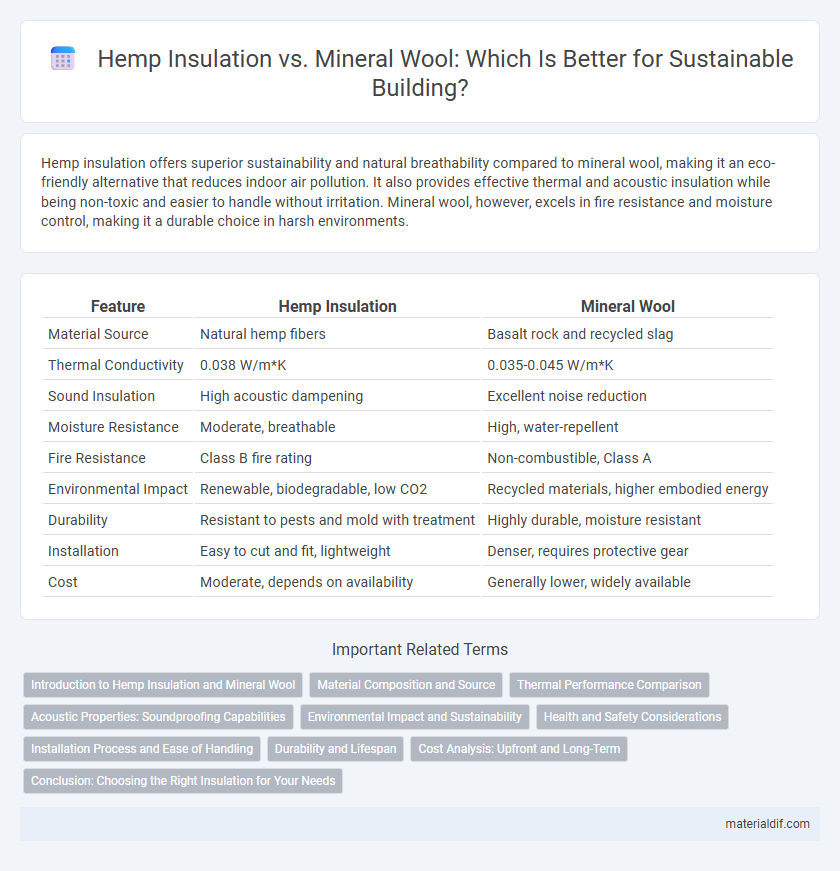Hemp insulation offers superior sustainability and natural breathability compared to mineral wool, making it an eco-friendly alternative that reduces indoor air pollution. It also provides effective thermal and acoustic insulation while being non-toxic and easier to handle without irritation. Mineral wool, however, excels in fire resistance and moisture control, making it a durable choice in harsh environments.
Table of Comparison
| Feature | Hemp Insulation | Mineral Wool |
|---|---|---|
| Material Source | Natural hemp fibers | Basalt rock and recycled slag |
| Thermal Conductivity | 0.038 W/m*K | 0.035-0.045 W/m*K |
| Sound Insulation | High acoustic dampening | Excellent noise reduction |
| Moisture Resistance | Moderate, breathable | High, water-repellent |
| Fire Resistance | Class B fire rating | Non-combustible, Class A |
| Environmental Impact | Renewable, biodegradable, low CO2 | Recycled materials, higher embodied energy |
| Durability | Resistant to pests and mold with treatment | Highly durable, moisture resistant |
| Installation | Easy to cut and fit, lightweight | Denser, requires protective gear |
| Cost | Moderate, depends on availability | Generally lower, widely available |
Introduction to Hemp Insulation and Mineral Wool
Hemp insulation is a sustainable, eco-friendly material derived from the natural fibers of the hemp plant, offering excellent thermal and acoustic properties while being breathable and resistant to mold. Mineral wool, made from volcanic rock or recycled slag, provides superior fire resistance, soundproofing, and moisture control but is less environmentally sustainable compared to hemp. Both materials serve as effective insulation options, with hemp favored for green building projects and mineral wool commonly used for enhanced fire safety and durability.
Material Composition and Source
Hemp insulation is made from natural hemp fibers derived from the stalks of the Cannabis sativa plant, offering a renewable, biodegradable alternative to synthetic materials. Mineral wool, also known as rock or stone wool, is produced from melted basalt rock and recycled industrial slag, providing non-organic, fire-resistant properties. The organic origin of hemp contrasts with the inorganic mineral base of mineral wool, influencing sustainability, thermal performance, and environmental impact.
Thermal Performance Comparison
Hemp insulation offers superior thermal performance with an average R-value of 3.5 per inch, providing effective heat retention and breathability that reduces moisture buildup compared to mineral wool's R-value of approximately 3.0 per inch. Hemp's natural fibers enhance insulation by trapping air pockets, improving energy efficiency and maintaining consistent indoor temperatures. Mineral wool, while fire-resistant and dense, often falls short in thermal regulation and moisture control compared to hemp's sustainable, eco-friendly properties.
Acoustic Properties: Soundproofing Capabilities
Hemp insulation offers superior sound absorption due to its natural fibers that effectively reduce airborne noise and vibrations, creating quieter indoor environments. Mineral wool also provides strong soundproofing by trapping sound waves within its dense, fibrous structure, making it highly effective for noise control in walls and ceilings. Comparing both, hemp insulation delivers enhanced acoustic comfort with eco-friendly benefits, while mineral wool excels in higher density sound attenuation for industrial applications.
Environmental Impact and Sustainability
Hemp insulation offers a lower environmental impact compared to mineral wool due to its renewable and biodegradable nature, requiring less energy for production and contributing to carbon sequestration during its growth. Mineral wool, while effective as an insulator, involves high-energy manufacturing processes and utilizes non-renewable resources, leading to greater greenhouse gas emissions. Hemp's biodegradability and ability to improve indoor air quality make it a more sustainable choice for eco-conscious construction projects.
Health and Safety Considerations
Hemp insulation offers superior indoor air quality benefits by being naturally mold-resistant, non-toxic, and free from harmful chemicals commonly found in mineral wool, which can irritate skin and respiratory systems. Unlike mineral wool, hemp fibers do not release harmful particulate matter during installation, reducing the risk of respiratory issues for installers and occupants. Hemp insulation also provides excellent moisture regulation, minimizing mold growth and enhancing long-term health safety in building environments.
Installation Process and Ease of Handling
Hemp insulation offers a lightweight and flexible material that allows for easy cutting and fitting around irregular spaces, reducing installation time compared to mineral wool. Mineral wool requires protective gear due to its coarse fibers, making handling less comfortable and slightly more labor-intensive. Hemp's natural composition minimizes irritation and promotes quicker, cleaner installation, especially in DIY projects.
Durability and Lifespan
Hemp insulation offers superior durability due to its natural resistance to mold, pests, and moisture, which helps maintain its structural integrity over time. Mineral wool, while fire-resistant and dense, can degrade faster when exposed to prolonged moisture, potentially compromising its lifespan. Hemp insulation typically lasts 20-30 years, often outlasting mineral wool, which averages around 15-25 years under similar conditions.
Cost Analysis: Upfront and Long-Term
Hemp insulation typically has a higher upfront cost compared to mineral wool due to its sustainable harvesting and processing methods. Over the long term, hemp offers better energy efficiency and durability, potentially reducing heating and cooling expenses more significantly than mineral wool. Mineral wool, while initially cheaper, may incur higher maintenance or replacement costs, making hemp a more cost-effective solution in sustainable building projects.
Conclusion: Choosing the Right Insulation for Your Needs
Hemp insulation offers superior sustainability with natural breathability and moisture regulation, making it ideal for eco-conscious homeowners seeking non-toxic options. Mineral wool excels in fire resistance and soundproofing, suitable for projects prioritizing safety and acoustic performance. Selecting between hemp and mineral wool depends on balancing environmental impact, thermal efficiency, and specific building requirements.
Hemp Insulation vs Mineral Wool Infographic

 materialdif.com
materialdif.com